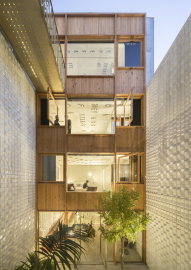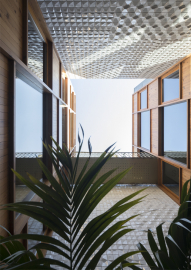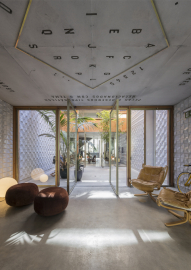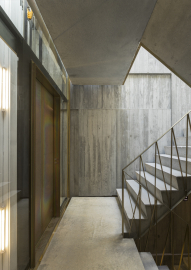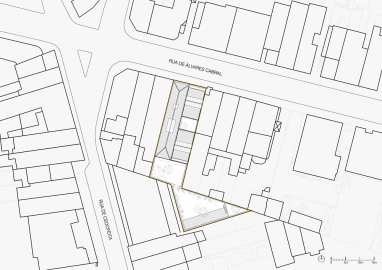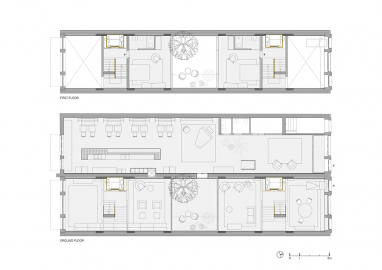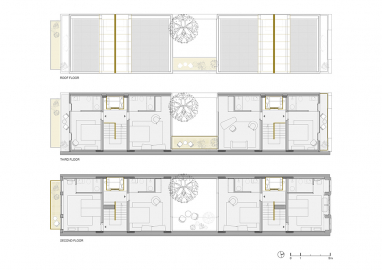Typography of Tale
Hotel Tipografia do Conto is a multifunctional space that links residential tourism and cultural events. It comprises ten rooms and a wide ground floor with multipurpose areas. Its architecture incorporates several memoirs of the pre-existing building and avoids the generic tourist offer which has been gentrifying many European cities (like Porto).
The project departs from an existing compound erected in 1916, to house small industrial activities (a Typography and a Graphic Workshop), which has since closed down. Over the last few years, the structure of the building has deteriorated, making it impossible to fully reuse it for the envisaged new functions. From this previous Workshop occupation, some memories remain at the new Hotel design: the main stone facade (in Deco style), the reuse of the central patio for lighting and ventilation, and its internal spatial flexibility, especially at the ground level. This evocation is extended to the design of the new facades around the patio – a typographic composition in a Riga wooden structure (reusing the beams of the former Workshop) –; but also, to the decorative elements on the ceilings, formed by bas-relief texts which allude to the idea of printing and typographic publishing.
The existing building was a broad industrial space that had to be transformed into a domestic-scale structure in order to include ten new rooms. To do so, the project avoids any kind of "pastiche" approach; instead, it recovers the “remnants” of an earlier condition integrating them into a contemporary design.
The Hotel rooms recall the old Workshop ambiences: in the proportions of the ceilings; in the way the glassed toilets cabinets are placed in the space; in the echoes of the elegant wood surfaces. All rooms are covered by specific scripts, written by ten selected authors, from writers to designers or architects. The scripts are converted into typographic text(ures) and inserted – in low relief – on the surface of the concrete ceilings. Punctual golden metal shears stand out from the ceiling backdrops, enriching the reading of those scripts.
The Hotel ground floor, which includes a wide Cultural Café, remains a long and flexible space, giving access to the central patio and backyard. It is used as a “stage” for different cultural events – concerts, workshops, exhibitions, book launches – intermediating between outdoor and indoor, and can be adapted to daily needs.
In general terms, concrete is the basic element of this project. Concrete is moulded or finished in three kinds of textures: “smooth” for ceilings and pavements; “striped” for the interior walls; and “rough” for the back facade. Inside, the concrete is accompanied by punctual elements in golden metal – in the decoration of ceilings, stair guards and elevator columns. In the central courtyard, another relationship is established between the new wooden facades, evoking the typographic plates that existed there, and an abstract carpeting of white tiles on the sidewalls.
All common areas prolong that contrasting relationship between the exposed concrete and the gilded metal surfaces, handrails and frames, between new details and recycled furniture objects. The rear facade, bordering the garden and the pool, was also rebuilt in exposed concrete (hammered in situ), maintaining a composition similar to that of the main front. In this way, the original alignments were kept, as well as the typological matrix of the existing lot.
The materials that require periodic maintenance are, essentially, concrete and wood. For that we apply water repellent and oil for wood.

